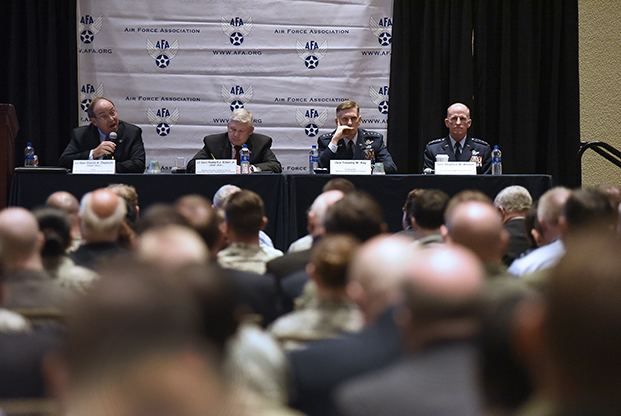
Retired Lt. Gen. David Deptula, dean of AFA’s Mitchell Institute, said the Air Force should postpone its plans to retire the B-1 and B-2 fleets in about 15 years, and should add to them a fleet of “at least 180” new B-21 stealth bombers, while retaining the B-52. Staff photo by Mike Tsukamoto.
The Air Force’s new suggested base force includes 14 bomber squadrons of 12 aircraft per squadron—five more squadrons than it has now—to deal with great power competition. But is that enough?
Retired Lt. Gen. David Deptula, dean of AFA’s Mitchell Institute, said the Air Force should postpone its plans to retire the B-1 and B-2 fleets in about 15 years, and should add to them a fleet of “at least 180” new B-21 stealth bombers, while retaining the B-52.
Speaking at a panel discussion during AFA’s Air, Space & Cyber force on long-range strike, Deptula said new operational requirements put a premium on range and payload, and asserted that it’s “premature for the Air Force to discuss” taking any bombers out of its inventory unless it already has the new aircraft to replace them. Such talk is “not productive” because it might convince Congress that upgrading those aircraft is not necessary.
Gen. Timothy Ray, head of Global Strike Command said the upgrades are in fact the command’s main “priority” right now.
Aircraft that have “range, responsiveness, survivability, and versatility” are needed to fulfill the new strategy, Deptula insisted, and the 157 aircraft now in the bomber fleet “are not enough to meet the strategy.”
The Mitchell Institute also released a new study at the event, “Building the Bomber Force America Needs: The Bomber Re-Vector.”
Retired Lt. Gen. Robert Elder, former commander of 8th Air Force, showed a chart based on RAND Corp. research indicating that nine bomber squadrons is only enough to deal with “one major war.” If a regional war is added onto the load, 14 squadrons are needed, but 16 bomber squadrons would be needed to deal with two major wars, all with “moderate” risk.
Not only are bombers well-suited to the emerging operational environment, given their ability to carry lots of relatively inexpensive weapons, when viewed in terms of cost per aimpoint, they are “a good deal” financially, Elder said.
Ray said the Air Force also will get a bargain on upgrading the older bombers because “we will get competition” into the process. However, he did not endorse the Mitchell numbers on bombers required. Ray said Monday that AFGSC’s Bomber Vector, which called for the retirement of the B-1 and B-2 in order to live within the command’s manpower footprint when the B-21 starts delivering, is still the plan until USAF directs otherwise.